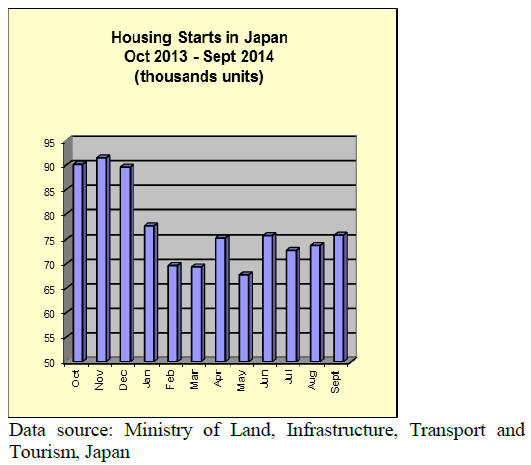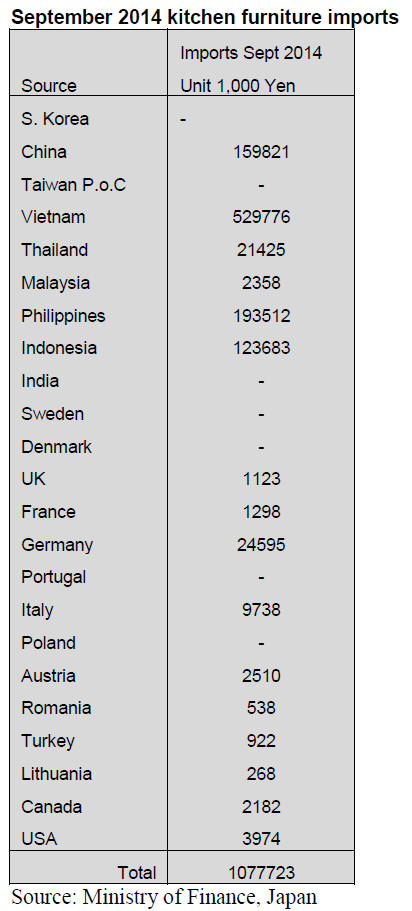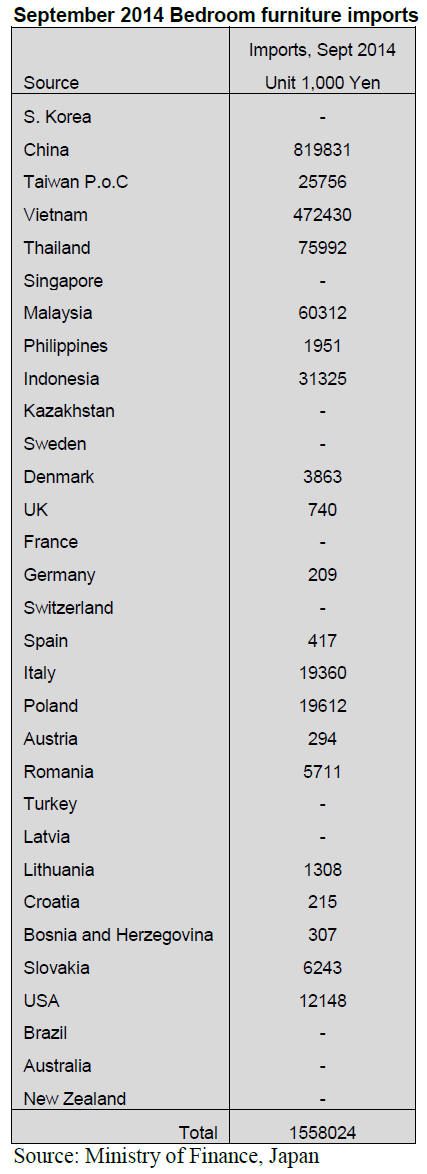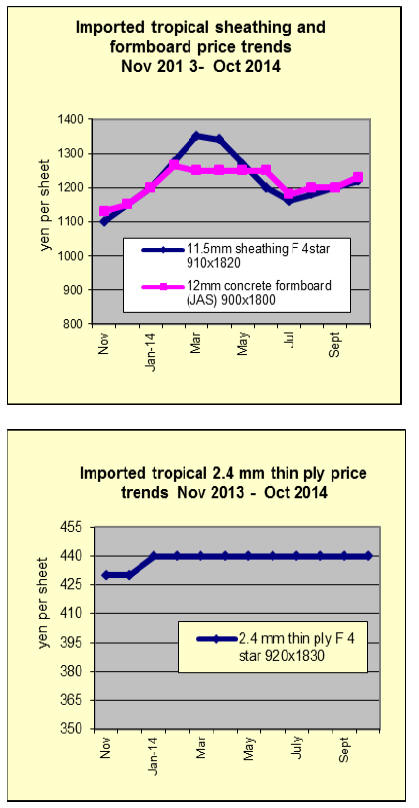Japan Wood Products
Prices
Dollar Exchange Rates of
27th October 2014
Japan Yen 108.16
Reports From Japan
Better than expected industrial production and retail
sales
September‟s industrial output expanded at the fastest pace
in eight months. Production in September was up 2.7%
from the previous month, an increase for the first time in
two months.
The sectors contributing most to the expansion of output
were transport equipment, electronic parts and devices and
electrical machinery. But the Ministry of Trade and
Industry is forecasting that production could decline 0.1%
in October but tip up again in November. Inventories held
by companies fell in September compared to August the
first fall for five months.
The better than expected news on output and the rise in
September retail sales, the third monthly increase in a row,
is boosting opinions that the economy may have turned the
corner after the collapse after the sales tax increase earlier
in the year.
For more see:
http://www.meti.go.jp/english/statistics/tyo/iip/index.html
But, doubts raised on pace of economic recovery
The latest data show that Japan's September exports
clocked the fastest growth in seven months boosted by
improved sales into Asian markets. However, renewed
signs of slowing global growth may undermine future
growth which would add more doubts to whether Japan‟s
economy is really recovering. Already the IMF has halved
its forecasts for growth in the Japanese economy for 2014.
The good news on exports was undermined as government
data shows the September trade deficit widening which if
not reversed would mean Japan ends 2014 with yet
another record deficit.
In its mid-October assessment of the outlook for the
economy the Japanese government maintained its
pessimistic forecast which is fuelling fears of a recession
and certainly raises doubts that the country could
withstand the second consumption tax increase scheduled
for next year.
Etsuro Honda, a University of Shizuoka professor and
economic adviser to Japan‟s Prime Minister has said in
public that the sales tax increase should be delayed as an
increase now would pose a huge threat to the fragile
economy.
Good and bad sides of weaker yen
At a recent parliamentary meeting the governor of the
Bank of Japan said that the weaker yen had the twin and
opposite effects of driving exports but undermining the
profitability of small and medium manufacturers which
rely on imported raw materials.
From a high of yen 106 to the US dollar in early October
there has be a steady decline in the exchange rate as
investors in Japan moved funds to US and European
bonds.
The dollar strengthened in anticipation of a rise in US
interest rates next year but a statement from the Federal
Reserve that a change may come later than expected
slowed the upward trend.

Year on year September housing down sharply
Data from the Ministry of Land, Infrastructure, Transport
and Tourism show that housing starts rose slightly on
levels a month earlier but were down just over 41% year
on year. August starts were down around 12% year on
year.
On an annualised basis 2015 housing starts, after including
the September data, will total 880,000. Annual starts were
841,000 in 2011, 893,002 in 2012 and 987,254 in 2013.
The survey conducted by the ministry reveals that
September orders received by the 50 largest building
contractors fell a massive 40% year on year.
For the full data see: http://www.estat.
go.jp/SG1/estat/ListE.do?lid=000001127843

Trends in office, kitchen and bedroom furniture
imports
Japan‟s office, kitchen and bedroom furniture imports
from 2009 to the end of September 2014 are shown below.
Japan‟s imports of bedroom furniture continued to fall in
September and imports of kitchen and office furniture
followed suit. The weakening of furniture imports
reinforces the view that consumer sentiment is negative
and that the economy is yet to recover from the
consumption tax increase in April.

Office furniture imports (HS 9403.30)
Office furniture imports were 18% down in September
compared to August levels and aprt for the slight rise in
August, imports have been falling since May this year.

The number one supplier of office furniture to Japan in
September was China (54%) followed by Italy (12%) and
Poland (6%). These three suppliers accounted for around
72% of all September office furniture imports.
China is the main supplier but saw its market share drop
by around 11%. The other main suppliers, Italy and Poland
also saw a decline in imports by Japan.
Kitchen furniture imports (HS 9403.40)
Overall, kitchen furniture imports by Japan fell by 3% in
September but the main supplier, Vietnam, saw trade rise
by around 6%. The other winner in September was
Indonesia which saw exports to Japan rise by almost 25%.
Other SE Asian suppliers of kitchen furniture to Japan,
such as Thailand and Malaysia, saw imports fall in
September.

Bedroom furniture imports (HS 9403.50)
Japan‟s September imports of bedroom furniture fell 6.6%
compared to August with China seeing its share of
bedroom furniture imports slide almost 13%.
The top three suppliers China, Vietnam and Thailand
accounted for the bulk (88%) of the bedroom furniture
imports but both China and Thailand saw their share of
imports fall. In contrast, Japan‟s September imports of
bedroom furniture from Vietnam rose 12%.
Suppliers in the EU and US account for just a small part of
Japan‟s bedroom furniture import and the value of these
countries monthly exports of bedroom furniture remains
fairly consistent.

Trade news from the Japan Lumber Reports (JLR)
For the JLR report please see:
http://www.nmokuzai.
com/modules/general/index.php?id=7
Imported south sea (tropical) hardwood plywood
Future cost of imported South Sea hardwood plywood has
been climbing sharply by recent steep depreciation of the
yen.
The supply side maintains bullish attitude and increases
the export prices before rainy season starts in October as
log cost would be going up by tight supply. The market in
Japan is rapidly firming under this situation.
The largest supplier in Malaysia has been raising the
export prices since last July by about USUS$10 per cbm
every month. Since last May, purchase by Japan decreased
because of depressed demand so the market prices have
been inching up gradually, pushed by higher import cost.
Up until early August, future cost was over market prices.
For instance, cost of JAS 3x6 concrete forming panel for
costing was 40-50 yen per sheet higher than the purchase
cost then the yen has started weakening rapidly since late
August and the cost of future purchase soared so the
difference between the cost and going market prices
widened. Thus, the market started tightening since the
third week of September.


Plywood export to Taiwan P.o.C
Seihoku Corporation (Tokyo) and Japan Kenzai Co., Ltd
(Tokyo) jointly plan to export 100% domestic softwood
plywood to Taiwan P.o.C. They plan to expand the export
market to other Asian countries in future. The first
container will sail to Taiwan P.o.C sometime in October
from Yokohama. This is trial shipment of about 1,200
sheets of 12 mm thick 3x6.
They plan to continue the shipment regularly every month
to develop market of items like floor base. Japan Kenzai‟s
subsidiary in Taiwan P.o.C will market in Taiwan P.o.C.
Seihoku has been seeking a chance to develop overseas
market then Japan Kenzai has overseas marketing base so
both interest fit the start of this business. Recent sharp
drop of the yen also helps promote this business.
In Taiwan P.o.C, majority of housing is condominiums so
that plywood is used for floor base. Normally floor is
placed directly on top of floor sheathing plywood.
Housing starts in Taiwan P.o.C in 2012 were about
100,000 units. Domestic plywood production is about
81,000 cbms while the imports are 639,200 cbms so share
of imports is high. Major source of plywood is 45.3%
from Malaysia, 41.8% from China, 11% from Indonesia.
Taiwan P.o.C uses plywood size of both 3x6 and 4x8.
Japan Kenzai estimates that size of plywood market in
Taiwan P.o.C is about 10% of Japan.
Plywood conference
Three countries regular plywood conference was held in
Jakarta, Indonesia in September. Indonesia, Malaysia and
Japan discussed and exchanged information on plywood
and relating materials. Supplying countries of Indonesia
and Malaysia reported various factors to push
manufacturing cost.
Indonesia reported that despite steady growth of domestic
demand, cost push factors like weak currency of Rupiah
and imported energy like oil will be burden for the
manufacturers.
Malaysia reported that minimum wage of workers is
significantly increased to 800 Ringgit a month since last
January then value added tax of 6% is introduced so the
manufacturing cost is up.
On new timber harvest right, allowable period is extended
to 60 years, which gives a chance to program long term
forest management but acquisition of forest certificate on
both natural and plantation timber by 2017, which is
another cost push factor.
Therefore, both countries hope to have a new price level
but Japan reported that the demand has been dwindling
after the consumption tax hike since last April and slump
seems to continue for some time.
Both supplying countries regard Japan as important market
but are concerned to declining export volume in shrinking
market and increase use of domestic softwood plywood
for base board and concrete forming panel.
Japan explained market condition of different kind of
plywood and the supply side asked many questions for use
of domestic species to which Japan replied that the supply
is not enough.
South Sea (tropical) logs
Log export prices are firming in Sarawak before rainy
season. In Sarawak, rain started since middle of August
and unstable weather continues before beginning of rainy
season in October and November.
Production of quality yellow meranti regular, which Japan
market looks for, is down and majority of supply is low
grade MLH and small diameter logs.
The Japanese buyers struggle to buy necessary logs. Some
say that up until 2012, two shipments a month were
regular pace but now because of lack of supply, even with
three ships in two months are hard to fill up ships.
In Sabah, log supply seems rather stable but it is necessary
to apply for export permit prior to two weeks of ship‟s
arrival so any extra volume is not allowed to load.
India keeps buying MLH and small logs. In India,
monsoon season is July through September so it will buy
more after Monsoon season is over.
Prices of low grade meranti logs for India are USUS$265
per cbm FOB, unchanged from September. Meranti
regular prices for Japan are USUS$280-295.Small
meranti is USUS$255-260 and super small is about
USUS$230.They are unchanged from September. |